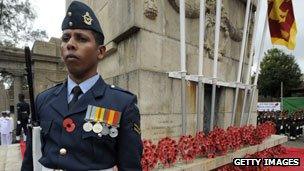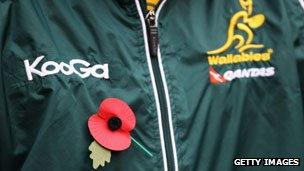Who, What, Why: Which countries wear poppies?
- Published

The poppy plays a big part in Sri Lankan ceremonies
England footballers will now be allowed to wear poppies when playing Spain at the weekend, says world football's governing body, Fifa. So what countries wear poppies to respect the war dead?
Premier League footballers were sporting poppies stitched on to their shirts while playing last weekend, but the gesture appeared to be ruled out for England's friendly against Spain at Wembley on Saturday, the day before Remembrance Sunday.
A Fifa edict last week said wearing poppies would break the rules about displaying political symbols - however, the ruling was reversed on Wednesday, after Prince William and Prime Minister David Cameron wrote to complain.
The practice of wearing a poppy at this time of year is not solely a British one. Indeed, the adoption of the poppy had a very international birth.
In November 1918, a poem by Canadian military doctor John McCrae inspired American humanitarian Moina Michael to wear and distribute poppies in honour of fallen soldiers.
In Flanders Fields describes the first sign of life after death - small red plants that grew on the graves of soldiers buried in northern France and Belgium during World War I.
Two days before the armistice agreement was signed, Ms Michael bought and then pinned a red poppy to her coat. She gave other poppies out to ex-servicemen at the YMCA headquarters in New York where she worked.
The poppy was officially adopted by the American Legion at a conference two years later. At the same conference, a French woman named Madame E Guerin saw an opportunity for orphans and widows to raise money in France by selling the poppies.
Since then, they have become an international symbol of remembering fallen soldiers, especially in Commonwealth countries.
The Royal British Legion, which adopted the poppy in 1921, distributed 45 million in 2010 in England, Wales and Northern Ireland. This year, it hopes to raise £40m ($64m) in donations, which will be used to assist retired or injured soldiers.
Three million poppies are sent to 120 countries outside the UK, says Nick Buckley, head of the legion's Poppy Appeal.
These are mostly for British expats living in countries such as Spain, Germany and France, he says. But the poppies, which are made in a factory in London and sent to British embassies in countries as varied as Argentina, Kazakhstan and Sri Lanka, are sometimes used by the local community as well.
In Scotland, about five million poppies are distributed each year by Poppyscotland, but they look slightly different. Unlike the standard two petals and a single green leaf, the Scottish ones have four petals and no leaf.
The Scottish poppy pin "is botanically correct", says Leigh James, spokeswoman for Poppyscotland. There's also a financial reason for the difference - adding a leaf would cost an extra £15,000 ($24,000) a year.
South Africa has seen a recent boom in the popularity of poppies, says Mariette Venter, national secretary at the South Africa Legion. "The poppy pin is now taking root here," she says.

Australia's rugby team have worn poppies
After a recent visit from Prince Charles, who wore a poppy on his lapel, the legion saw a spike in phone calls from people asking where they could get one. The legion in South Africa had 300,000 poppies shipped from England's poppy factory this year, along with 50 wreaths.
Ms Venter says she also sent 200 poppies to Malawi for use in ceremonies there.
Canada is distributing 18 million poppies for Remembrance Day this year, says Bob Butt of the Royal Canadian Legion. Canadian poppies, which are made in Toronto, have four petals with a black centre and no leaf - like Scotland's.
In New Zealand, Poppy Day usually falls on the Friday before Anzac Day, which is commemorated on 25 April.
The reason is a historical one - the ship carrying the poppies from France for the first Poppy Day in 1921 came too late for them to be used in November's Armistice Day.
In the same year, Australia bought one million poppies from French orphans. Nowadays, they are made locally and are laid next to names on the Roll of Honour.
In the US, the country where the first poppies were worn in this way, the sight of them has diminished around the armistice anniversary.
The 11th day of November is known as Veterans Day, when a more common adornment on the lapel is a red, white and blue ribbon. But there are some poppies laid and worn for Memorial Day in May, in parts of the US.
The poppy has been a divisive issue in Ireland, particularly Northern Ireland, where it is regarded by many Republicans as a mark of loyalty to the British Crown.
One of the blackest days in the Troubles saw the IRA bombing a Remembrance Day ceremony in Enniskillen, when 11 people were killed and more than 60 injured.
In France, the blue cornflower, "le bleuet" is also worn, but not as widely as the poppy in the UK.